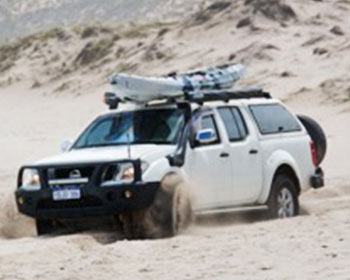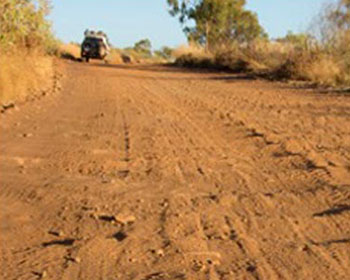Why are 4WD Tyre Pressures so Important
Understanding how tyre air pressure affects your 4WD tyres is a brilliant place to start. When you head off the bitumen road, 4WD tyre pressures become the most critical thing you can easily control. It is literally the difference between getting stuck, and cruising through!
You are probably familiar with letting air out of your tyres when you head off road, but what’s the reasoning behind it, and why is it so important?
Increased Traction
Traction is king when it comes to 4WDing. If you don’t have traction, your 4WD isn’t going anywhere.You can have any motor in your 4WD, and the best suspension setup, but if you can’t physically get your tyres to grip the ground, you aren’t going to move.
By letting air out of your tyres, they bulge at the bottom and the surface area of rubber touching the ground increases. If you look end on, you will see the tyres increase in width a reasonable amount, but it’s the increase in length that makes all the difference. It’s possible to double the surface area touching the ground when you let air out of your tyres, and that makes a massive difference.
Explore the Dueler A/T 697 range.
Greater Flotation
As mentioned above, when you deflate air from your tyres, the surface area touching the ground increases. Aside from giving you extra traction, it also provides greater flotation. If your 4WD weighs 3 tonnes, and is spread over 4 small contact areas, it’s much more likely to sink than if you were to double the contact patches.
It’s the same as walking down the beach; try and do it on your tippy toes and you sink down, but if you use the full surface area of your foot you won’t sink half as much.
Increased Puncture Resistance
Tyre damage when off road is common, and in many cases it comes down to running the wrong tyre pressures for the terrain being driven. When your tyres are at full pressure, it’s much easier for a sharp rock to penetrate through the rubber and cause a puncture.
However, if you reduce your tyre pressure, it tends to mould its way around the sharp rock instead of being pierced. If you take a balloon, and pump it up tight and touch it on a sharp rock, it will pop almost immediately. Do the same thing with a balloon that’s only half full of air though, and it will mould around the rock and sit there without a problem.
However, as you deflate your tyres, you expose more side wall, which can make it easier to get a puncture through the side of the tyre, so bear it in mind when driving around sticks and tree roots that can damage the sidewall.
Better Vibration Absorption
We have some terrible tracks in Australia. Bone jarring and 4WD destroying tracks that will leave you feeling like a milkshake. However, if you deflate your tyres correctly, and pick the right speed, those bumps and shocks are dramatically reduced.Corrugations are a part of driving around Australia in a 4WD, and anyone who’s been on bad corrugations will tell you the importance of reducing air from your tyres. When you let air out, the tyres mould themselves around the bumps and much less of the shock is passed through the 4WD, and to you.
It’s better for the tyre wear, the rest of your 4WDs and it makes the trip much more comfortable. Use the tyres air pressure to absorb as much of the shock as possible by picking a safe and suitable speed.
4WD Tyre Pressures and Heat
When you drive a 4WD, the tyre flexes, which creates heat. This in turn warms the air inside the tyre, and makes the air pressure go up. It’s not uncommon to see a 6 PSI difference between hot and cold air pressures, and this is something you must pay attention to. 22 PSI can easily turn into 28 PSI on a badly corrugated road. The more your tyres deform and the faster you drive the hotter your tyres will get, which results in greater air pressure increase.
Rolling a Tyre Off The Bead
If you go too low in air pressure, it becomes very easy to roll a tyre off the rim. Essentially the bead separates from the wheel, and your tyre comes off (partly or entirely). This can be dangerous, and best case scenario it’s very inconvenient, so keep this at the back of your mind.
The most common time tyres are rolled off beads is on soft sand, where you need your tyre pressures down as low as they ever get. The way to avoid it is to accelerate, brake and corner smoothly and without any suddenness. If you try to turn quickly and sharply with your tyres deflated, it’s easy to roll a tyre off the bead. Usually this is the front wheel, but it can happen to the rear as well.
What Is The Right Tyre Pressure?
Tyre pressures should be varied according to the terrain you are driving on, the weight of your vehicle, speed you are travelling and tyre size.
The faster you are driving, the higher your tyre pressures should be. The more your 4WD weighs, the higher your tyre pressures should be. The bigger your tyres, the less air you need.
It’s impossible to give a generic guide, as 4WDs range from 1.2 tonnes all the way to 3.5, and your pressures should vary for each situation.
Look at the tyre placard on your 4WD, and see what the recommended inflation is for bitumen driving, and stick to that on sealed roads (the figure given is usually for an unloaded vehicle).
For sand driving, tyre pressures are as low as you will let them down. For some 4WDs this is around the 15- 20 PSI mark, but there are cases where you may need to go lower if it is very soft. At the lower end of the scale a few PSI makes a huge difference.
Mud and rock driving is done at a slightly higher pressure than this, and gravel roads slightly higher again (around 30% off the tyre placard). It’s not accurate to give figures that cover majority of 4WDs out there, so we won’t go too far into it. It’s crucial to inspect and reinflate tyres before heading back onto bitumen. If you don’t, you run the risk of tyre failure or possibly having an accident.
Learn how to check your tyre pressure.
Start With Good Quality 4WD Tyres
Don’t discount the need to run good quality 4WD tyres. They are extremely important, and buying poor quality tyres to save a few dollars will be a decision you regret. Match the tread pattern to where you use your 4WD, ensure they have good puncture resistance and are light truck, and you can’t go too wrong.
Next time you jump in your 4WD, spare a thought for the air pressure in your 4WD Tyres!
Explore more about the Bridgestone 4x4 and SUV tyre range.
Share your best 4WD tyre pressure tip with us or join the conversation on Facebook.





